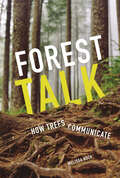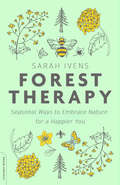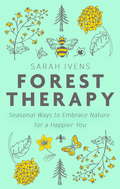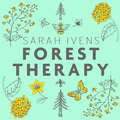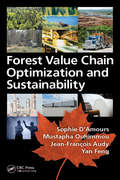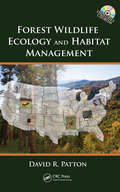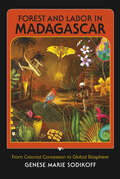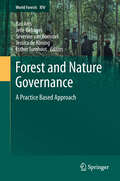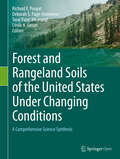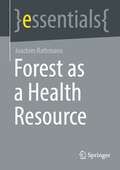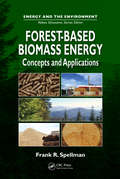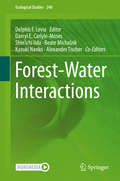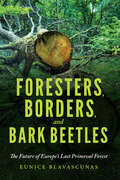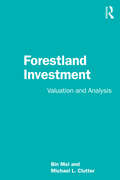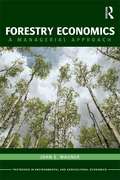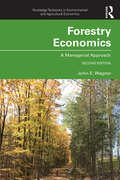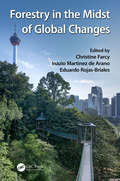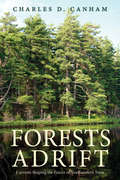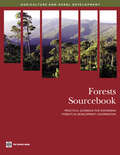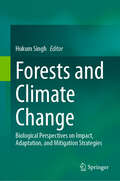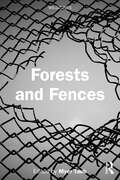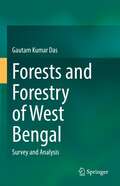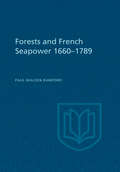- Table View
- List View
Forest Talk: How Trees Communicate
by Melissa KochTrees are essential. They provide water, shelter, and food for millions of plant and animal species, including humans. They deliver proven health benefits, and they capture and store carbon, which combats climate change. Yet trees are in trouble. Forests are struggling to adapt to climate change, and deforestation is a major threat. Recently, researchers and citizen scientists made the surprising revelation that trees communicate with each other through an underground system of soil fungi and other methods. Complex social networks help trees survive and thrive by transferring resources to each other, sending defense signals, communicating with their kin, and more. Meet the tree scientists and learn more of their fascinating discoveries.
Forest Therapy: Seasonal Ways to Embrace Nature for a Happier You
by Sarah IvensYour practical guide to better health, stronger relationships, and a happier life--by reconnecting with nature There is something simply soul-soothing about being in nature. In fact, research shows that spending time outside can improve the immune system, combat stress hormones, lower blood pressure, and boost self-esteem. Around the globe, rising movements are driving us to reconnect with Mother Nature--from shinrin-yoku ("forest bathing") in Japan to friluftsliv ("open-air life") in Scandinavia--yet our everyday lifestyles have distanced us from the great outdoors. For stressed-out professionals, reclusive bookworms, worn-out parents, and their cooped-up kids, Forest Therapy shares why getting back to nature is critically important for our well-being, and offers fun, easy practices to break out of hibernation.Forest bathing is a rising trend, but what to do if you're not near the woods or if the weather is dreary? Forest Therapy offers practical steps and inspiration to tap into nature's restorative power, no matter the season or the weather. Chapters address ideas for all four seasons, as well as ways to use experiences in nature as ways to deepen your relationships with your children, partner, and friends. Ivens's creative ideas and strategies range from a simple walk in the woods and countryside couples' therapy to DIY natural beauty products and simple ways to bring the great outdoors into your home. Illustrated with charming black-and-white line art, Forest Therapy is a warm, witty, and personal guide to improving your health, finding happiness, and living a fabulous al fresco life.
Forest Therapy: Seasonal Ways to Embrace Nature for a Happier You
by Sarah IvensWho hasn't felt better after a walk in the woods, a picnic alfresco or a swim in the sea? There is something soul-soothingly simple and refreshing about getting back to nature, about making the most of the great outdoors, being mindful of Mother Nature's gifts and grabbing spring and summer - and those blue sky, brisk days of autumn and winter - with both hands. But sadly it is a skill we are losing. We are becoming creatures wrapped in walls and trapped by to-do lists, hibernating while the world sprouts, grows and changes.From a simple walk in the woods and countryside couples therapy to DIY natural beauty products and how to bring the outdoors to your home, Forest Therapy will provide seasonal tips to help you reconnect with nature. This book is not just for mountain climbers or white water rafters - it is for uninspired fathers wanting to reconnect their families, bookworms looking to shake off their cobwebs, cooped-up kids needing to let off steam, stressed-out professionals wanting to stop and smell the flowers and worn-down mums needing a rejuvenating boost. We all know getting outside is good for us. Our ancestors did it. We should too. This book will help you live your most unforgettable, fabulous alfresco life.
Forest Therapy: Seasonal Ways to Embrace Nature for a Happier You
by Sarah IvensWho hasn't felt better after a walk in the woods, a picnic alfresco or a swim in the sea? There is something soul-soothingly simple and refreshing about getting back to nature, about making the most of the great outdoors, being mindful of Mother Nature's gifts and grabbing spring and summer - and those blue sky, brisk days of autumn and winter - with both hands. But sadly it is a skill we are losing. We are becoming creatures wrapped in walls and trapped by to-do lists, hibernating while the world sprouts, grows and changes.From a simple walk in the woods and countryside couples therapy to DIY natural beauty products and how to bring the outdoors to your home, Forest Therapy will provide seasonal tips to help you reconnect with nature. This book is not just for mountain climbers or white water rafters - it is for uninspired fathers wanting to reconnect their families, bookworms looking to shake off their cobwebs, cooped-up kids needing to let off steam, stressed-out professionals wanting to stop and smell the flowers and worn-down mums needing a rejuvenating boost. We all know getting outside is good for us. Our ancestors did it. We should too. This book will help you live your most unforgettable, fabulous alfresco life.
Forest Value Chain Optimization and Sustainability
by Sophie D’Amours, Mustapha Ouhimmou, Jean-François Audy and Yan FengThis book provides a global perspective on the various issues that the industry has to face as well as to provide some key global strategies that can help coping with those global challenges, such as collaboration, strategic value chain planning, and interdependency analyses. It presents literature reviews, strategic research orientations, assessment of some current key issues, and state-of-the-art methodologies.
Forest Wildlife Ecology and Habitat Management
by David R. PattonAcross the continental United States, one can identify 20 distinct forest cover types. Most of these are to be found on federal lands managed by the U.S. Forest Service and Bureau of Land Management. Those responsible for the management of trees that form the 20 different cover types and the diversity of forest wildlife that reside in them must hav
Forest and Labor in Madagascar: From Colonial Concession to Global Biosphere
by Genese Marie SodikoffA study of the demands of economic development and ecological conservation on the African island country.Protecting the unique plants and animals that live on Madagascar while fueling economic growth has been a priority for the Malagasy state, international donors, and conservation NGOs since the late 1980s. Forest and Labor in Madagascar shows how poor rural workers who must make a living from the forest balance their needs with the desire of the state to earn foreign revenue from ecotourism and forest-based enterprises. Genese Marie Sodikoff examines how the appreciation and protection of Madagascar’s biodiversity depend on manual labor. She exposes the moral dilemmas workers face as both conservation representatives and peasant farmers by pointing to the hidden costs of ecological conservation.“Sodikoff takes us deep into the underbelly of conservation in one of the world’s biodiversity “hot-spots.” It is a world of timber barons, logging gangs, corrupt state functionaries, international conservation experts, worker-peasants, and poachers. She paints eastern Madagascar as a frontier of dispossession, exploitation, and violence. The plundering of the Mananara protected area is seen, in a brilliantly original way, from the subaltern vantage point of forest workers and conservation labor. Forest and Labor places present day conservation on the larger canvas of a century of forest-based social relations of labor that have entered into the making of what Sodikoff calls neoliberal conservation. It is a magnificently rich historical and ethnographic accounting of what passes as the making of global biosphere reserves. A tour de force.” —Michael Watts, UC Berkeley“An important and lively contribution to the study of “green neoliberalism.” An obvious choice for undergraduate teaching on ecology, rights, international political economy, development, and a host of other topics.” —David Graeber, University of London“Brings a whole new angle and nuance to the crucial debates over conservation and development. Applicable not just to lush, humid eastern Madagascar, but all around the globe.” —Christian Kull, Monash University“Those interested in conservation, tropical rainforest ecology, international political economy, and sustainable development will find Forest and Labor in Madagascar an insightful case study.” —Choice
Forest and Nature Governance
by Jelle Behagel Bas Arts Jessica De Koning Esther Turnhout Séverine Van BommelToday, problems such as deforestation, biodiversity loss and illegal logging have provoked various policy responses that are often referred to as forest and nature governance. In its broadest interpretation, governance is about the many ways in which public and private actors from the state, market and/or civil society govern public issues at multiple scales. This book takes a fresh perspective on the study of forest and nature governance. Departing from 'practice theory', and building upon scholars like Giddens, Bourdieu, Reckwitz, Schatzki and Callon, it seeks to move beyond established understandings of institutions, actors, and knowledge. In so doing, it not only presents an innovative conceptual and methodological framework for a practice based approach, but also rich case studies and ethnographies. Finally, this book is about how actors involved in governance talk about and work with trees, forests, biodiversity, wildlife, and so on, while acting upon forest policies, environmental discourses, codes of conduct, or scientific insights.
Forest and Rangeland Soils of the United States Under Changing Conditions: A Comprehensive Science Synthesis
by Toral Patel-Weynand Richard V. Pouyat Deborah S. Page-Dumroese Linda H. GeiserThis open access book synthesizes leading-edge science and management information about forest and rangeland soils of the United States. It offers ways to better understand changing conditions and their impacts on soils, and explores directions that positively affect the future of forest and rangeland soil health. This book outlines soil processes and identifies the research needed to manage forest and rangeland soils in the United States. Chapters give an overview of the state of forest and rangeland soils research in the Nation, including multi-decadal programs (chapter 1), then summarizes various human-caused and natural impacts and their effects on soil carbon, hydrology, biogeochemistry, and biological diversity (chapters 2–5). Other chapters look at the effects of changing conditions on forest soils in wetland and urban settings (chapters 6–7). Impacts include: climate change, severe wildfires, invasive species, pests and diseases, pollution, and land use change. Chapter 8 considers approaches to maintaining or regaining forest and rangeland soil health in the face of these varied impacts. Mapping, monitoring, and data sharing are discussed in chapter 9 as ways to leverage scientific and human resources to address soil health at scales from the landscape to the individual parcel (monitoring networks, data sharing Web sites, and educational soils-centered programs are tabulated in appendix B). Chapter 10 highlights opportunities for deepening our understanding of soils and for sustaining long-term ecosystem health and appendix C summarizes research needs. Nine regional summaries (appendix A) offer a more detailed look at forest and rangeland soils in the United States and its Affiliates.
Forest as a Health Resource (essentials)
by Joachim RathmannJoachim Rathmann presents the interdisciplinary links between forests and human health. Forests provide numerous ecosystem services for the survival, well-being, and maintenance and enhancement of human health. Forests provide multisensory recreational spaces and can therefore be considered a resource that positively impacts both physical, mental, and social aspects of health. The author presents natural science, social science, and humanities research in an understandable, clear, and concise manner for a diverse readership.
Forest-Based Biomass Energy: Concepts and Applications (Energy and the Environment)
by Frank SpellmanWhat is forest-based biomass energy and why should we care? Written by environmental expert Frank Spellman, Forest-Based Biomass Energy: Concepts and Applications details how forest biomass can be converted to energy and energy products, including direct combustion, pellets, gasification, and co-firing. It explores the possibilities of forest-based
Forest-Water Interactions (Ecological Studies #240)
by Delphis F. Levia Darryl E. Carlyle-Moses Shin’ichi Iida Beate Michalzik Kazuki Nanko Alexander TischerThe United Nations has declared 2018-2028 as the International Decade for Action on Water for Sustainable Development. This is a timely designation. In an increasingly thirsty world, the subject of forest-water interactions is of critical importance to the achievement of sustainability goals. The central underlying tenet of this book is that the hydrologic community can conduct better science and make a more meaningful impact to the world’s water crisis if scientists are: (1) better equipped to utilize new methods and harness big data from either or both high-frequency sensors and long-term research watersheds; and (2) aware of new developments in our process-based understanding of the hydrological cycle in both natural and urban settings. Accordingly, this forward-looking book delves into forest-water interactions from multiple methodological, statistical, and process-based perspectives (with some chapters featuring data sets and open-source R code), concluding with a chapter on future forest hydrology under global change. Thus, this book describes the opportunities of convergence in high-frequency sensing, big data, and open source software to catalyze more comprehensive understanding of forest-water interactions. The book will be of interest to researchers, graduate students, and advanced undergraduates in an array of disciplines, including hydrology, forestry, ecology, botany, and environmental engineering.
Foresters, Borders, and Bark Beetles: The Future of Europe's Last Primeval Forest
by Eunice Blavascunas“A compelling investigation of the pasts and possible futures of a critical ecosystem in an era of globalization and rising nationalism.” —Andrew S. Mathews, author of Instituting NatureIn Europe’s last primeval forest, at Poland’s easternmost border with Belarus, the deep past of ancient oaks, woodland bison, and thousands of species of insects and fungi collides with authoritarian and communist histories.Foresters, biologists, environmentalists, and locals project the ancient Bialowieza Forest as a series of competing icons in struggles over memory, land, and economy, which are also struggles about whether to log or preserve the woodland; whether and how to celebrate the mixed ethnic Polish/Belarusian peasant past; and whether to align this eastern outpost with ultraright Polish political parties, neighboring Belarus, or the European Union. Eunice Blavascunas provides an intimate ethnographic account, gathered in more than 20 years of research, to untangle complex forest conflicts between protection and use. She looks at which pasts are celebrated, which fester, and which are altered in the tumultuous decades following the collapse of communism.Foresters, Borders, and Bark Beetles is a timely and fascinating work of cultural analysis and storytelling that textures its ethnographic reading of people with the agency of the forest itself and its bark beetle outbreaks, which threaten to alter the very composition of the forest in the age of the Anthropocene. “Through vivid storytelling, Eunice Blavascunas illuminates the durability of struggles around national identity and history—and the ways those struggle shape debates over ecology and nature conservation—in one of Europe’s quintessential borderlands.” —Katrina Z. S. Schwartz, author of Nature and National Identity after Communism
Forestland Investment: Valuation and Analysis
by Bin Mei Michael L. ClutterForestland investment has surged in the past few decades as a result of land ownership change in the forestry industry. Timberland investment and management organizations and real estate investment trusts have bought up land and resources that were divested by vertically integrated forest products companies. This book provides a seminal coverage of this seismic shift in the industry, exploring the philosophy, driving factors, valuation, theory, research, implementation, practice, and effects of forestland investment. Across 15 chapters the book reviews the history of forestland investment; discusses the optimal forest rotation; explains timberland appraisal; examines the return drivers of forestland; analyzes timberland index construction methods and results; prices timberland assets; reviews financial and real options; investigates real option values in forestland management; evaluates timber harvest contracts; examines new opportunities in the emerging woody bioenergy market; and eventually offers prospects on forestland investment in the future. It also discusses how forest carbon can be used as a nature-based climate solution. This book is essential reading for forestry business students and scholars, as well as practitioners and policymakers in the industry.
Forestry Economics: A Managerial Approach (Routledge Textbooks In Environmental And Agricultural Economics Ser.)
by John E. WagnerForestry Economics introduces students and practitioners to all aspects of the management and economics of forestry. The book adopts the approach of managerial economics textbooks and applies this to the unique processes and problems faced by managers of forests. While most forestry economics books are written by economists for future economists, what many future forest and natural resource managers need is to understand what economic information is and how to use it to make better business and management decisions. John E. Wagner draws on his twenty years of experience teaching and working in the field of forest resource economics to present students with an accessible understanding of the unique production processes and problems faced by forest and other natural resource managers. There are three unique features of this book: The first is its organization. The material is organized around two common economic models used in forest and natural resources management decision making. The second is the use of case studies from various disciplines: Outdoor and Commercial Recreation, Wood Products Engineering, Forest Products, and Forestry. The purpose of these case studies is to provide students with applications of the concepts being discussed within the text. The third is revisiting the question of how to use economic information to make better business decisions at the end of each chapter. This ties each chapter to the preceding ones and reinforces the hypothesis that a solid working knowledge of these economic models and the information they contain are necessary for making better business decisions. This textbook is an invaluable source of clear and accessible information on forestry economics and management for not only economics students, but for students of other disciplines and those already working in forestry and natural resources.
Forestry Economics: A Managerial Approach (Routledge Textbooks in Environmental and Agricultural Economics)
by John E. WagnerForestry Economics introduces students and practitioners to the economics of managing forests and forest enterprises. The book adopts the approach of managerial economics textbooks and applies this to the unique problems and production processes faced by managers of forests and forest enterprises. What many future forest and natural resource managers need is to understand what economic information is and how to use it to make better business and management decisions. John E. Wagner draws on his 30 years of experience teaching and working in the field of forest resource economics to present students with an accessible understanding of the unique production processes and problems faced by forest and other natural resource managers. The second edition has been updated to include: Expanded discussion of compounding, discounting, and capital budgeting, as well as an expanded discussion of when to replace a capital asset that has (i) costs but no direct revenue stream such as a machine; (ii) costs and a direct annual revenue stream such as a solar array; or (iii) costs and a periodic revenue stream illustrated by the forest rotation problem. New practical examples to provide students with applications of the concepts being discussed in the text, most notably on New Zealand and a Radiata Pine (Pinus radiata) Plantation. A brand-new chapter that develops business plans for for-profit businesses to illustrate how a business plan is derived from the economic information contained within the Architectural Plan for Profit and how it can be used to make business decisions about continuing to operate a business or to start a new business. This textbook is an invaluable source of clear and accessible information on forestry economics and management not only for economics students, but also for students of other disciplines and those already working in forestry and natural resources.
Forestry Economics: A Managerial Approach (Routledge Textbooks in Environmental and Agricultural Economics)
by John E. Wagner- Each chapter introduces one or more key concepts in managerial economics and then illustrates the importance of those ideas by showing how they can be applied when making business decisions.- The inclusion of numerous case studies throughout the book enables students to see how forestry and natural resource management works in practice.- A new chapter on developing and writing business plans highlights a managerial tool and allows students to put the ideas developed throughout the book into practice.
Forestry in the Midst of Global Changes
by Christine Farcy Eduardo Rojas-Briales Inazio Martinez de AranoForestry today, like many other sectors that traditionally rely on material goods, faces significant global drivers of societal change that are less often addressed than the environmental concerns commonly in the spotlight of scientific, political, and news media. There are three major interconnected issues that are challenging forestry at its foundation: urbanization, tertiarization, and globalization. These issues are at the core of this book. The urbanization of society, a process in development from the first steps of industrialization, is particularly significant today with the predominance and quick growth rate of the world’s urban population. Ongoing urbanization is creating new perspectives on forestry, inducing changes in its social representation, and changing lifestyles and practices with a tendency toward dematerialization. The process of urbanization is also creating a disconnect and in some ways is leaving behind rurality, the sector of society where forestry has traditionally developed and taken place over centuries. The second issue covered in this book is the tertiarization of the economy. In society today, the sector of services largely dominates the economy and occupies the major part of the world’s active population. This ongoing process modifies professional modalities and ways of life and opens new doors to forests through the immaterial goods they provide. It also profoundly changes the framework, rules, processes, means of production, exchanges between economic factors, and the processes of innovation. The third issue is undoubtedly globalization in its economic, political, and social components. Whether it’s through bridging distances, crossing borders, accelerating changes, standardizing practices, leveling hierarchical structures, or pushing for interdependence, globalization impacts everyone, everywhere in multiple ways. Forestry is no exception. Forestry in the Midst of Global Changes focuses on these global drivers of change from the perspective of their relationships with how society functions. By analyzing them in depth through multidisciplinary, interdisciplinary, and even transdisciplinary approaches, this book is helping to design the forestry of tomorrow.
Forests Adrift: Currents Shaping the Future of Northeastern Trees (The Future Series)
by Charles D. CanhamA captivating analysis of the past, present, and future of northeastern forests and the forces that have shaped them The northeastern United States is one of the most densely forested regions in the country, yet its history of growth, destruction, and renewal are for the most part poorly understood—even by specialists. In this engaging look at both the impermanence and the resilience of the northeastern forest ecosystems, Charles D. Canham provides a synthesis of modern ecological research and explores critical threats that include logging, fire suppression, disease, air pollution, invasive species, and climate change. Providing a historical perspective on how northeastern forests have changed since the arrival of European settlers, Canham also utilizes new theoretical models to predict how these ecosystems will change and adapt to an uncertain future. This is an informed and accessible investigation of an endangered natural landscape that examines the ramifications of the scientific controversies and ethical dilemmas shaping the future of northeastern forests.
Forests Sourcebook
by World BankThe 'Forests Sourcebook' provides practical operations-oriented guidance for forest sector engagement toward the goals of poverty reduction, conservation and economic development. Intended to guide World Bank lending activities and projects, the 'Forests Sourcebook' offers information useful to a broad audience of practitioners, government agencies, and non-governmental organizations. The 'Sourcebook was developed in partnership with members of the Collaborative Partnership on Forests, including the Food and Agriculture Organization. The 'Sourcebook' provides background on key issues, lessons learned, and recommendations for practitioners on a number of topics including private sector engagement, forest governance, sustainable plantation and commercial harvesting, and forest information management systems. Giving insight into the complex interplay between different realms of development work that effect or are affected by forests, the 'Forests Sourcebook' is a valuable tool for any stakeholder involved in development or business projects that could have impact on forests.
Forests and Climate Change: Biological Perspectives on Impact, Adaptation, and Mitigation Strategies
by Hukum SinghThis book comprehensively examines the complex relationship between forests and climate change from a biological perspective. It explores the effects of climate change, such as rising temperatures, greenhouse gas emissions, changing rainfall patterns, droughts, and cold spells, on individual trees and forest ecosystems. It considers how climate change affects forest structure, function, composition, and biodiversity, and the adaptive strategies forests employ to cope with changing conditions. The book focuses on understanding the adaptive capacity of forests and explores different mechanisms at stand and ecosystem levels that enable forests to respond to changing climatic conditions. It discusses how forests acclimate and adapt to new climates by modulating growth rates, morphology, phenology, physiology, biochemistry, and species composition. The role of genetic diversity and evolutionary processes in shaping forest resilience and adaptation is also explored. The book also explores potential mitigation strategies to reduce the impacts of climate change. Besides, this book discusses the ecological principles and the involvement of local communities in conservation and restoration efforts as alternative strategies to enhance the resilience of forest ecosystems against climate change. The book provides practical recommendations for policy makers, forest managers, and conservation practitioners to develop effective climate change adaptation and mitigation strategies in forest landscapes. This book serves as a valuable resource and a guide for researchers, students, and professionals in various fields to protect and sustainably manage vital ecosystems in a rapidly changing climate.
Forests and Fences (WildZones)
by Myer TaubThis book examines critical themes in environmental studies though theatre and performance studies. It experiments with forms along with the practice of praxis to provide radical frameworks for resilience in the contemporary age of crisis. Drawing on Ravi Sundaram’s concept of “Wild Zones”, it explores the kinetic overflows in informal sites, but also in the intimate spaces that have been realigned or shocked or fenced in, especially in the context of the COVID-19 pandemic.This volume will be of great interest to scholars and researchers of theatre and performance studies, environment and sustainability, and environmental humanities.
Forests and Forestry of West Bengal: Survey and Analysis
by Gautam Kumar DasThis book explains several basic concepts of forests and forestry research like social distancing of trees, solitary trees, green infrastructure of trees including typical forest stands like pocket forests, forgotten forests, community forests, and social forestry from one forest stand to another scattered in the districts of West Bengal. In the field of forest floors, depleting status of the forests stimulates to find out different models of afforestation programme like tree-island and rescue forest strategy through plantation programme. Huge loss of tree canopy ravaged by the series of cyclonic storms particularly in the districts of South Bengal seems to be recovered by bioeconomic model with the implementation of social forestry schemes. Thoughts of such models incited the author to go through statistical analysis on different matters and parameters of the forest stands. Determination of physico-chemical parameters of the forest soil are carried on hand in hand with the identification of Alfisol profile exposures in the forest floors. For finding out the present status of forests, district-wise review is worked out. Though scattered in the format of the forest patches, forest stands in the Jungle Mahal are remarkably interesting for any surveyor or tree-lover. Because of the reasons, surveys in the specific forest lands like Joypur and Beliatore of Bankura district and Garh Jangal and Aduria Forests under Bardhaman Forest Division are given special impetus for statistical measures, soil properties analysis, and identification of vegetation pattern. All these salient features inspire the author to take an attempt disseminating information and related characteristics of the forests and forestry of West Bengal. Researchers and students will get sufficient material from this book to enrich their knowledge on the forest environment and the author believes that this book will act as the pioneer work for the flourishment and amelioration of the forestry of West Bengal.
Forests and French Sea Power, 1660-1789
by Paul Walden BamfordBy choosing to concentrate upon discovering what forest resources were available to the French navy during the ancien régime and what use it was able to make of them, Mr. Bamford has not only provided the first monograph on that subject in the English language, but has gone far toward explaining why France was the loser in the long duel with England for the control of commerce and the extension of empire. <P><P> Two years of research in the Archives Nationales and in the Archives de la Marine in Paris, Toulon, and Rochefort enabled him to draw on contemporary sources of information of which little, if any, use has been made before, and a further year of research in the libraries of New York City, particularly in the rich Proudfit Naval Collection, also yielded new material. It is Mr. Bamford's achievement to have handled this vast store of primary sources with such skill and judgement that the reader, by turning over letters from disgruntled forest proprietors, reports from harassed maîtres on the trickery and recalcitrance of the peasants, instructions from the top echelon of the navy to inspectors in the forests, and a variety bills, receipts, and memoranda, is given at first hand an appreciation of the difficulties faced by the navy in trying to obtain timber and masts of the choice quality required for building ships-of-the-line. The navy had to compete with the merchant marine and with industrial and private users of fuel for supplies that were continually being depleted by mismanagement and by the conversion of forests to arable land. Measures, superficially admirable, for conserving the forests are found on closer examination to be at once over-precise and not properly enforced. Transport, even in a country so abundantly supplied with navigable rivers as France, was expensive and difficult.<P>Not only historians, but scholars in the field of forestry, economics, geography, agriculture, and transport will find this book illuminating.
Forests and Global Change
by David A. Coomes David F. R. P. Burslem William D. Simonson David A. Coomes David F. R. P. Burslem William D. SimonsonForests hold a significant proportion of global biodiversity and terrestrial carbon stocks and are at the forefront of human-induced global change. The dynamics and distribution of forest vegetation determines the habitat for other organisms, and regulates the delivery of ecosystem services, including carbon storage. Presenting recent research across temperate and tropical ecosystems, this volume synthesises the numerous ways that forests are responding to global change and includes perspectives on: • the role of forests in the global carbon and energy budgets • historical patterns of forest change and diversification • contemporary mechanisms of community assembly and implications of underlying drivers of global change • the ways in which forests supply ecosystem services that support human lives. The chapters represent case studies drawn from the authors' expertise, highlighting exciting new research and providing information that will be valuable to academics, students, researchers and practitioners with an interest in this field.
